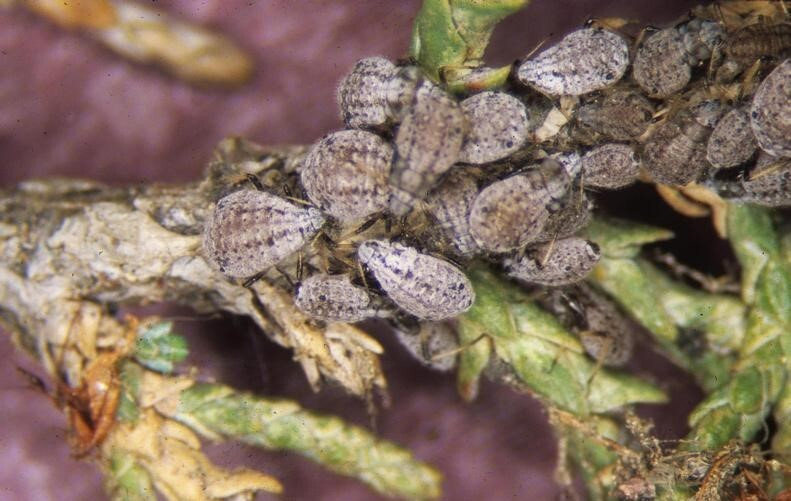Giant Conifer Aphids (Cinara spp.)

Figure 1. Giant conifer aphids on a juniper. Photo by W. Cranshaw, CSU, Bugwood.
Host
Conifers
Damage and Symptoms
In large groups, the aphids can often blend in with the bark. Aphids feed on the sap from woody areas of the tree. Heavy infestations can cause needle drop, yellowing, curling of the needles, and dieback. The aphids also produce copious amounts of honeydew.
Life Cycle
Females lay eggs on needles in late summer. In the spring, eggs hatch and aphids reproduce asexually throughout the summer. Early season populations are on the terminal growth and upper areas of the tree.

Figure 2. Giant conifer aphids clustering at base of needles. Photo by B. Hammon, CSU, Bugwood.
Management
Heavy aphid populations can be a sign of stress, and evergreens often suffer from environmental stress due to planting issues (planted too deep) or being under watered. Aphid populations tend to be higher in plants/trees that are highly fertilized. Hose off aphids with a strong stream of water. Placing cardboard wraps with Tanglefoot around the tree can also help. Aphids are controlled by natural enemies when populations are low. For chemical control, contact insecticides that are labeled for the host can be used in early to late spring.
Further Information
To learn more about the topics discussed on this page, contact MSU Extension arthropod diagnostician Dr. Laurie Kerzicnik. If you suspect an infestation on your property, contact your local extension agent, the Schutter Diagnostic Lab at Montana State University, or the Montana Department of Agriculture.
This fact sheet is also available as a printable PDF (305KB).
Disclaimer: These recommendations are provided only as a guide. It is always the pesticide applicator’s responsibility, by law, to read and follow all current label directions for the specific pesticide being used. The authors and Montana State University assume no liability resulting from the use of these recommendations. The Montana State University Extension Service is an ADA/ EO/AA/Veteran’s Preference Employer and Provider of Educational Outreach.
